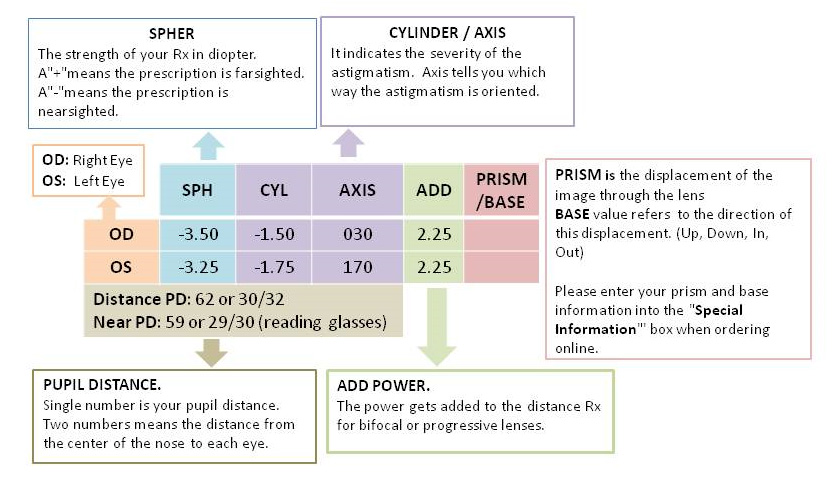


So, you've just had an eye exam and your eye doctor has given you an eyeglass prescription. He or she probably mentioned that you are nearsighted or farsighted, or perhaps you have astigmatism.
But what do all those numbers on your eyeglass prescription mean? And what about all those abbreviated terms, such as OD, OS, SPH and CYL?
The first step to understanding your eyeglass prescription is knowing what "OD" and OS" mean. They are abbreviations for oculus dexter and oculus sinister, which are Latin terms for "right eye" and "left eye."
Your eyeglass prescription also may have a column labeled "OU." This is the abbreviation for the Latin term oculus uterque, which means "both eyes."
Though use of these abbreviated Latin terms is common on prescriptions for glasses, contact lenses and eye medicines, some doctors and clinics have opted to modernize their eyeglass prescriptions and use RE (right eye) and LE (left eye) instead of OD and OS.
On your eyeglasses prescription, the information for your right eye (OD) comes before the information for your left eye (OS). Eye doctors write prescriptions this way because when they face you, they see your right eye on their left (first) and your left eye on their right (second).
Your eyeglass prescription contains other terms and abbreviations as well. These include:
Sphere (SPH). This indicates the amount of lens power, measured in diopters
The term "sphere" means that the correction for nearsightedness or farsightedness is "spherical," or equal in all meridians of the eye.
Cylinder (CYL). This indicates the amount of lens power for astigmatism. If nothing appears in this column, you have little or no astigmatism that requires correction.
The term "cylinder" means that this lens power added to correct astigmatism is not spherical, but instead is shaped so one meridian has no added curvature, and the meridian perpendicular to this "no added power" meridian contains the maximum power and lens curvature to correct astigmatism.
The number in the cylinder column may be preceded with a minus sign (for correction of nearsighted astigmatism) or a plus sign (for farsighted astigmatism). Cylinder power always follows the sphere power in an eyeglass prescription.
Axis. This describes the lens meridian that contains no cylinder power to correct astigmatism. The axis is defined with a number from 1 to 180. The number 90 corresponds to the vertical meridian of the eye, and the number 180 corresponds to the horizontal meridian.
If an eyeglass prescription includes cylinder power, it also must include an axis value, which follows the cyl power and is preceded by an "x" when written freehand.
The axis is the lens meridian that is 90 degrees away from the meridian that contains the cylinder power for astigmatism correction.
Add. This is the added magnifying power applied to the bottom part of multifocal lenses to correct presbyopia. The number appearing in this section of the prescription is always a "plus" power, even if it is not preceded by a plus sign. Generally, it will range from +0.75 to +3.00 D and will be the same power for both eyes.
Prism. This is the amount of prismatic power, measured in prism diopters ("p.d." or a superscript triangle when written freehand), prescribed to compensate for eye alignment problems. Only a small percentage of eyeglass prescriptions include prism.
When present, the amount of prism is indicated in either metric or fractional English units (0.5 or ½, for example), and the direction of the prism is indicated by noting the relative position of its "base" (thickest edge). Four abbreviations are used for prism direction: BU = base up; BD = base down; BI = base in (toward the wearer's nose); BO = base out (toward the wearer's ear).
Sphere power, cylinder power and add power always appear in diopters. They are in decimal form and generally are written in quarter-diopter (0.25 D) increments.
Axis values are whole numbers from 1 to 180 and signify only a meridional location, not a power. When prism diopters are indicated in decimal form, typically only one digit appears after the period.